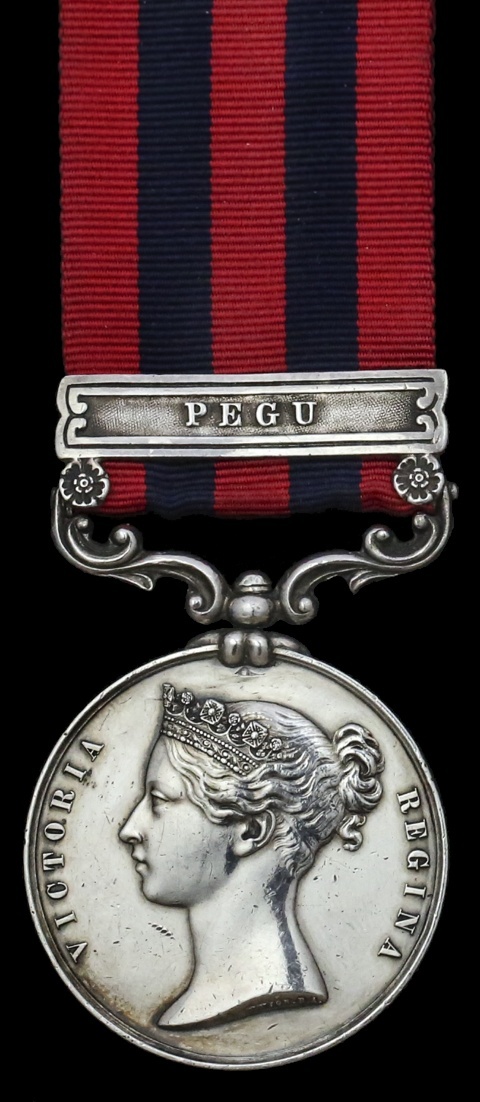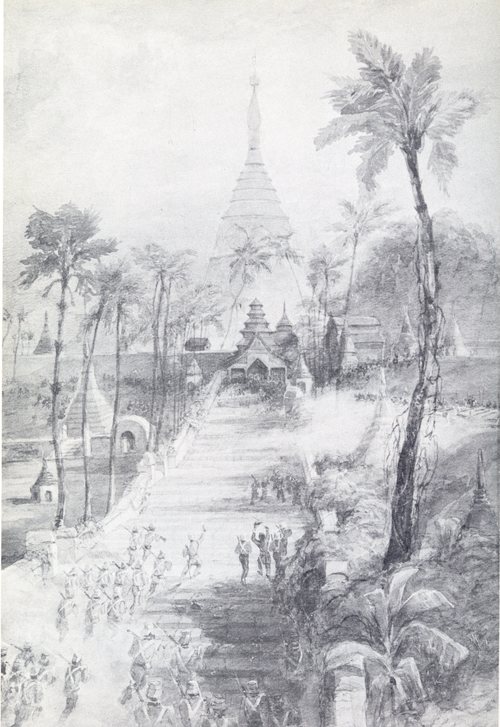Auction: 17001 - Orders, Decorations and Medals
Lot: 15
(x) 'On nearing the city [Prome], the squadron came under the enemy's fire, which was returned, the ships anchoring, and covering the landing of the 80th under Lieutenant-Colonel G. Hutchinson … the enemy occupied a fine position on a range of hills covering the city, about 1,000 yards from the point of landing. The 80th were exposed to a smart musketry and jingal fire, but Captain Christie, with the Grenadier Company, advanced at the double towards the large Pagoda occupied by the Burmese, while another party, consisting of two Companies of the 80th, under Captain Welsh, attacked on the left, and, in the words of General Godwin's despatch, 'most gallantly drove the enemy out of their position with the loss of only one man killed and a few wounded … '
A History of the South Staffordshire Regiment (1705-1923), by James P. Jones, refers.
A fine storming party leader's India General Service 1854-95 Medal awarded to Colonel A. T. Welsh, 109th Foot, late 80th (Staffordshire Volunteers) and 8th (The King's) Regiments: having been present at the capture of the Great Dagon Pagoda in Rangoon, he led a similar enterprise against a Pagoda at Prome in September 1852, his 'gallantry and dash' winning him a mention in despatches and the thanks of the Governor-General of India
India General Service 1854-95, 1 clasp, Pegu (Captn. A. T. Welsh, 80th Regt.), minor contact marks and edge nicks, good very fine
Astell Thomas Welsh was born in Youghall, Co. Cork, on 15 May 1821, the son of Robert Welsh and Anna Maria Perkins.
Young Astell was commissioned Ensign by purchase in the 80th (Staffordshire Volunteers) Regiment in May 1841. His brother, Robert Charles Welsh, also an Army officer, was murdered in the same year, while on home leave at Hacketstown, Co. Waterford. Travelling by horse and gig, he was robbed and beaten to death, The Wexford Independent reporting that his body was discovered in a hedge, only a mile from the family home.
Having been advanced to Lieutenant, without purchase, in July 1844, Astell married Julia Darling in Sydney, New South Wales, in November of the same year; the marriage produced two daughters, Julia, born in 1847, and Annie, born in 1855.
Meanwhile, he had served with distinction in the Second Burma War 1852-53, being present at the bombardment and capture of Rangoon, where he was present at the storming of the Great Dagon Pagoda. A fiercely protected bastion, the spectacular 14th century pagoda was defended by cannon over its three main tiers, in addition to being protected by a brick and mud rampart. The force chosen to storm the Pagoda comprised a detachment of the 80th, including Welsh, two Companies of the 18th (Royal Irish) Regiment and some troops from 40th Bombay Native Infantry. An approach march having been made before dawn through jungle, the ranks of the storming party readied themselves for the attack. James Jones's History of the South Staffordshire Regiment (1705-1923) takes up the story:
'The distance to be covered in the advance to the eastern entrance of the Pagoda was 800 yards. The troops crossed steadily under a heavy fire from the walls crowded with the enemy. When the storming party reached the Pagoda steps, a rush was made for the upper terrace, and a deafening cheer told that the Pagoda was won. The enemy evacuated the place in great confusion, and were severely handled by the troops and the fire from the steamers on the river.'
Duly qualified in pagoda-storming tactics, Welsh went on to lead a similar enterprise at the capture of a large Pagoda in Prome in September 1852, when, as cited in General Godwin's subsequent despatch (London Gazette 3 December 1852, refers), he 'most gallantly drove the enemy out of their position with the loss of only one man killed and a few wounded.' He was likewise thanked by the Governor-General of India and, having also been present in the operations around Poungdey in March-April 1853, received the Medal & clasp.
In July 1856, Welsh exchanged to the 8th (The King's) Regiment, in which capacity he was given the brevet rank of Major - in India - in May 1861. He subsequently received the brevet rank of Major in the British army in May 1863, the same month in which he exchanged to the 109th (Bombay Infantry) Regiment of Foot. Having then been given the brevet rank of Lieutenant-Colonel in the summer of 1873, he was placed on the Retired List with the honorary rank of Colonel at the end of the same year.
Welsh spent the last years of his life at 81, The Chase, Clapham Common, where he died on 19 March 1904.
Reference sources:
Bruce, George, The Burma Wars 1824-1886 (Hart-Davis, MacGibbon, London, 1973).
Jones, James P., A History of the South Staffordshire Regiment (1705-1923) (Whitehead Brothers, Wolverhampton, 1923).
Parritt, Brigadier Brian, A Dangerous Game, British Colonial Warfare on the Sub-Continent 1854-95 (Loose End Publishing, 2010).
The Wexford Independent
Subject to 5% tax on Hammer Price in addition to 20% VAT on Buyer’s Premium. For more information please view Terms and Conditions for Buyers.
Sold for
£1,900







